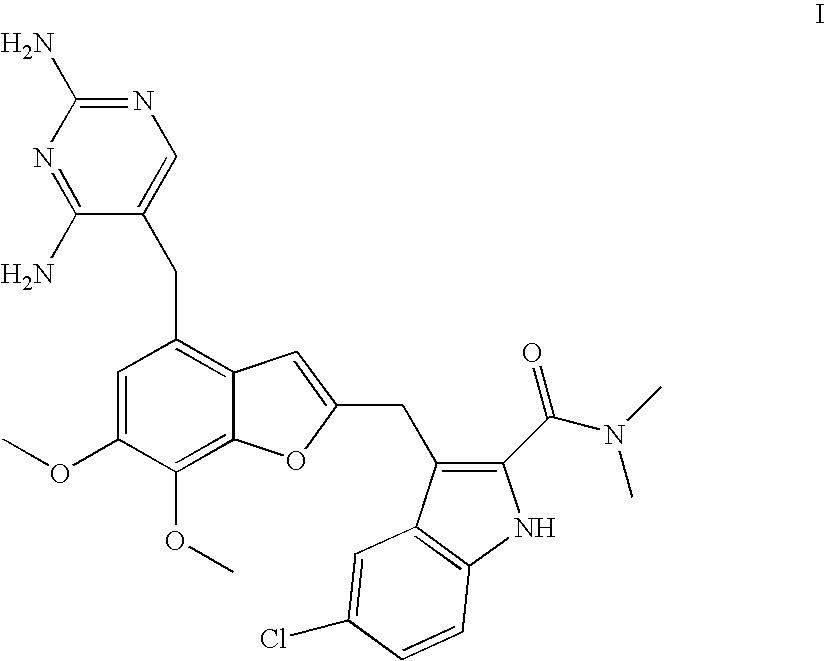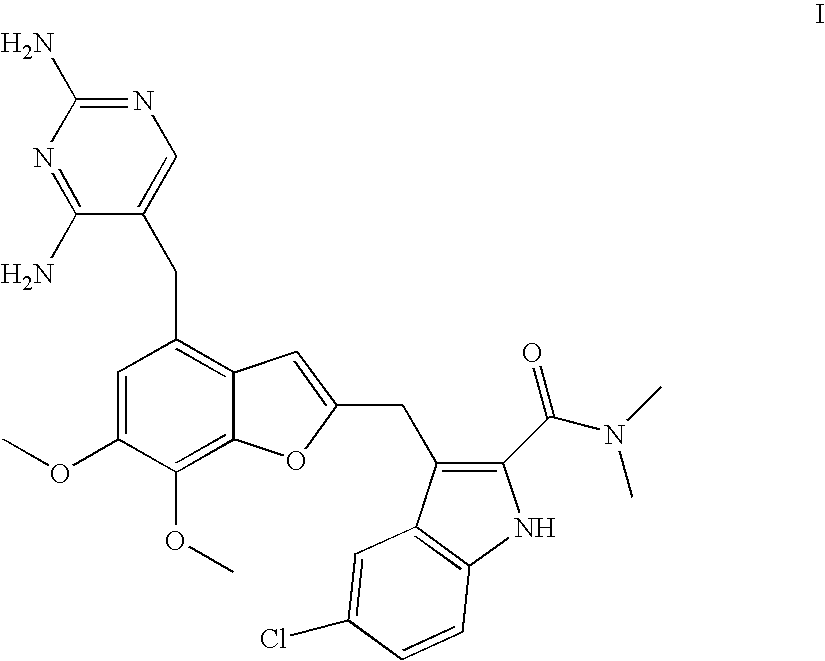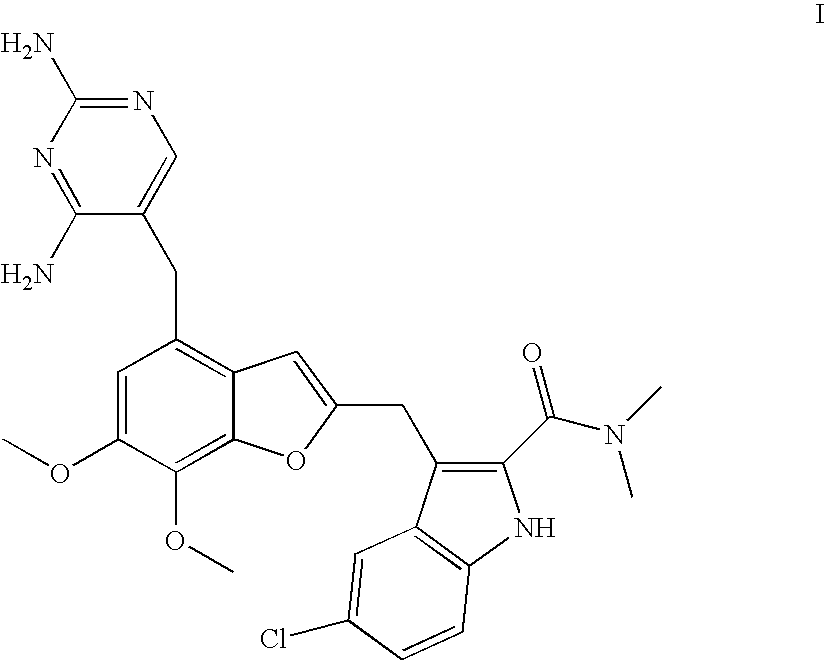Novel Processing for the Preparation of a Benzofuran
a technology of benzofuran and processing technology, applied in the field of new processing technology, can solve the problems of low overall yield, short synthesis time, and less economic attractiveness of synthesis for preparing commercial quantities
- Summary
- Abstract
- Description
- Claims
- Application Information
AI Technical Summary
Benefits of technology
Problems solved by technology
Method used
Image
Examples
example 1
[0031]This example illustrates the preparation of N-[4-(2,2-Dimethyl-propionylamino)-5-(3,4,5-trimethoxy-benzyl)-pyrimidin-2-yl]-2,2-dimethyl-propionamide 2 (R=C(CH3)3) (step A1).
[0032]A solution of trimethoprim (5 g, 17.24 mmol) in pivalic anhydride (8.74 mL, 43.10 mmol, 2.5 eq.) was heated during 2 h at 150° C. under argon. Hot AcOEt was added, and the organic layers were washed with aqueous NaHCO3 10%, water and brine. The org. layers were then dried over MgSO4, filtered and evaporated. It was then recrystallized from TBME to give 3.02 g of compound 2 (R=C(CH3)3).
1H-NMR (CDCl3, 400 MHz) δ: 8.35 (s, 1 H), 8.21 (br s, 1 H), 7.65 (br s, 1 H), 6.30 (s, 2 H), 3.86 (s, 2 H), 3.79 (s, 3 H), 3.77 (s, 6 H), 1.31 (s, 9 H), 1.12 (s, 9 H). mp: 130-133° C.
example 2
[0033]This example illustrates the preparation of N-[4-isobutyrylamino-5-(3,4,5-trimethoxy-benzyl)-pyrimidin-2-yl]-isobutyramide 2 (R=CH(CH3)2) (step A1).
[0034]A solution of trimethoprim (50 g, 172.4 mmol) in isobutyric anhydride (100 g, 105 mL, 632 mmol, 3.6 eq.) was heated during 2 h at 150° C. under argon. The warm solution was poured into 1 L of cyclohexane from where it slowly crystallized. The product was filtered off and was washed thoroughly with cyclohexane (2×200 mL) to give 70 g of compound 2 (R=CH(CH3)2).
1H-NMR (D6-DMSO, 400 MHz) δ: 10.42 (s, 1H, NH); 10.15 (s, 1H, NH); 8.41 (s, 1H, pyrimidine); 6.41 (s, 2H, PhH); 3.81 (s, 2H, CH2); 3.70 (s, 6H, 2×OCH3); 3.59 (s, 3H, OCH3); 2.72-2.85 (m, 2H, CH); 1.06 (d, 6H, J=6.6 Hz, 2×CH3), 1.01 (d, 6H, J=6.6 Hz, 2×CH3. mp: 153-154° C. Rt (02)=1.65 minutes.
example 3
[0035]This example illustrates the preparation of N-[4-isobutyrylamino-5-(3,4,5-trimethoxy-benzyl)-pyrimidin-2-yl]-isobutyramide 2 (R=CH(CH3)2) (step A1).
[0036]A solution of trimethoprim (50 g, 172.4 mmol) in isobutyric anhydride (62 g, 65.5 mL, 392 mmol, 2.3 eq.) was heated during 2 h at 150° C. under Ar and stirred with a mechanical stirrer. The solution was cooled to 130° C. and 200 ml toluene was added (clear solution), then 1000 ml TBME was slowly added (after 500 ml crystallization started) under vigorous stirring. The thick crystal cake was stirred for 1 hour at 100° C. external temperature. Then the slurry was cooled to RT and stirred for 2 hours. Finally the slurry was cooled to 10° C. and stirred for 2 hours. The crystals were filtered and washed with 3 times 90 ml TBME to remove residual isobutyric acid and anhydride. The crystals were dried at HV / 70° C. for 8 hours to give 70 g of compound 2 (R=CH(CH3)2).
1H-NMR (D6-DMSO, 400 MHz) δ: 10.42 (s, 1H, NH); 10.15 (s, 1H, NH); ...
PUM
| Property | Measurement | Unit |
|---|---|---|
| temperature | aaaaa | aaaaa |
| temperature | aaaaa | aaaaa |
| temperature | aaaaa | aaaaa |
Abstract
Description
Claims
Application Information
 Login to View More
Login to View More - R&D
- Intellectual Property
- Life Sciences
- Materials
- Tech Scout
- Unparalleled Data Quality
- Higher Quality Content
- 60% Fewer Hallucinations
Browse by: Latest US Patents, China's latest patents, Technical Efficacy Thesaurus, Application Domain, Technology Topic, Popular Technical Reports.
© 2025 PatSnap. All rights reserved.Legal|Privacy policy|Modern Slavery Act Transparency Statement|Sitemap|About US| Contact US: help@patsnap.com



